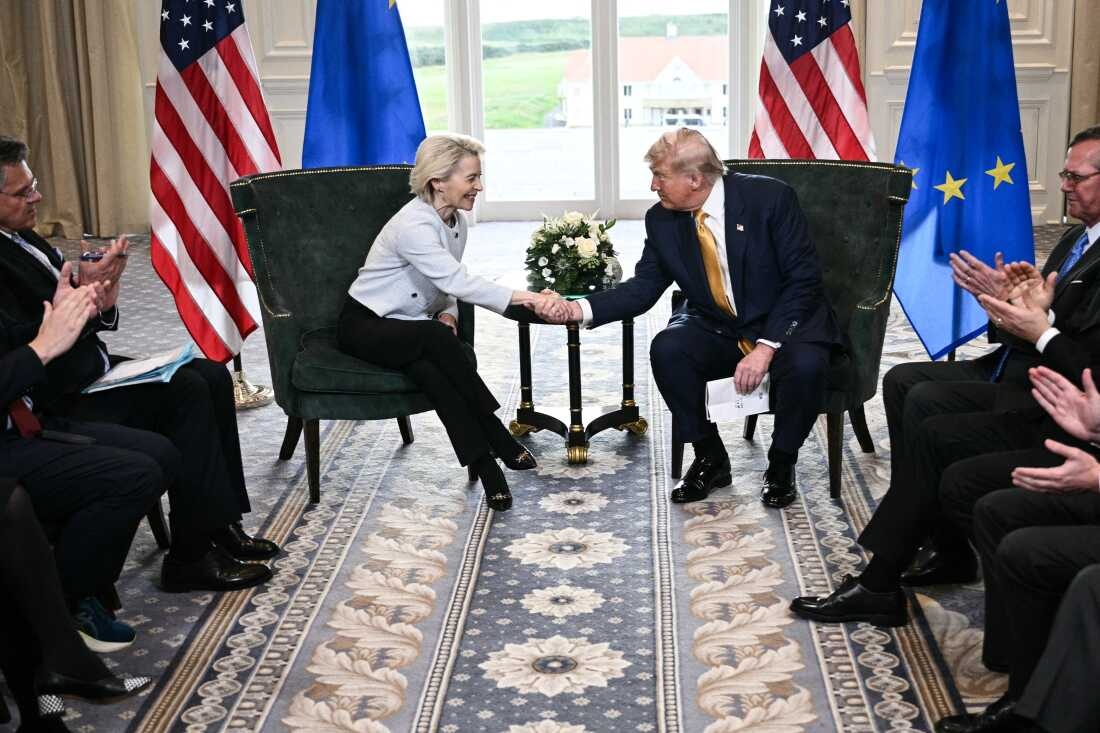Trump Clinches Landmark Trade Deal with EU, Avoids Tariff War with 15% Levy and $1.35tn Investment Pledge

President Donald Trump announced a landmark trade agreement between the United States and the European Union on Sunday, narrowly averting a potentially bruising tariff war just days before the August 1 deadline.
The deal, reached after intense negotiations with European Commission President Ursula von der Leyen, imposes a 15% tariff on most European goods entering the U.S., including automobiles, while also delivering massive EU commitments to U.S. energy, military, and investment markets.
The agreement represents a middle ground between Trump’s earlier 30% tariff threat and the EU’s demand to retain 10% baseline rates. It also comes with significant concessions from Brussels, including a $750 billion purchase of U.S. energy and $600 billion in additional EU investment into the American economy, on top of existing levels. Trump said the EU would also purchase “hundreds of billions of dollars worth of military equipment,” although he didn’t disclose an exact amount.
Register for Tekedia Mini-MBA edition 18 (Sep 15 – Dec 6, 2025) today for early bird discounts. Do annual for access to Blucera.com.
Tekedia AI in Business Masterclass opens registrations.
Join Tekedia Capital Syndicate and co-invest in great global startups.
Register for Tekedia AI Lab: From Technical Design to Deployment.
“This is a very powerful deal. It’s a very big deal. It’s the biggest of all the deals,” Trump declared Sunday.
Von der Leyen, echoing Trump’s tone, called the agreement “a good deal, a huge deal, with tough negotiations.”
Tariff Terms and Exemptions
The 15% tariff will apply to a wide range of European exports, with major implications for industries like automobiles and consumer goods. However, certain sectors such as aircraft and aerospace components, specific chemicals, and pharmaceuticals are exempt, von der Leyen said. Notably, the newly imposed 15% tariff will not be added on top of any existing tariffs, providing a modicum of relief to European exporters.
The move comes as both sides scrambled to avoid a collapse in talks, which had been teetering until just days ago. Trump, in a press briefing before his meeting with von der Leyen, had pegged the chances of a deal at “50-50.” European officials had been preparing for a breakdown, authorizing counter-tariffs and even considering deployment of the EU’s “Anti-Coercion Instrument,” which some in Brussels described as the bloc’s “trade bazooka.”
$1.35 Trillion in Economic Commitments
Beyond tariffs, the deal is notable for its sheer economic scale. The $750 billion EU commitment to U.S. energy — including liquefied natural gas, oil, and renewables — represents one of the largest single pledges ever made by the bloc. It underscores Europe’s intent to diversify energy sources amid growing geopolitical uncertainty.
The EU also committed to $600 billion in new investments across U.S. infrastructure, tech, and manufacturing, a move Trump said would drive American jobs and supply chain independence.
While Trump touted the military procurement component, von der Leyen offered little detail, sparking speculation about future defense contracts involving NATO-aligned purchases of American aircraft, defense systems, and cybersecurity technologies.
European Leaders Weigh In
European capitals responded with a mix of relief and caution. Irish Prime Minister Micheál Martin praised the agreement as a stabilizing force, saying it “brings clarity and predictability” to the trading relationship, but acknowledged that higher tariffs would “make trade between the EU and the US more expensive and more challenging.”
Germany’s Chancellor Friedrich Merz — whose country’s powerful auto sector stood to lose the most — welcomed the outcome, emphasizing that reducing auto tariffs from 27.5% to 15% was a lifeline.
“With the agreement in the EU-US negotiations on tariffs, a trade conflict, which would have hit the export-oriented German economy hard, has been avoided,” Merz said in a statement.
Dutch Prime Minister Dick Schoof offered a more tempered reaction, writing on X: “No tariffs would have been better, but this deal brings clarity for our businesses and provides more market stability.”
Averting a Crisis
The deal averts what economists and trade experts had warned would be a mutually damaging showdown between the world’s two largest economic blocs. In 2024, U.S.-EU trade in goods and services totaled €1.68 trillion ($1.97 trillion), with the EU running a €50 billion overall surplus, according to the European Council.
Brussels had been under pressure to hold the line, especially after Washington’s hardline stance in previous trade spats with Canada, Mexico, and China. The threat of steep tariffs had rattled global markets, and the EU’s decision to meet Trump halfway — while extracting carve-outs and investment guarantees — is being hailed in diplomatic circles as a pragmatic compromise.
But critics say the burden of higher tariffs will be felt by consumers and businesses on both sides of the Atlantic. The agreement also leaves unresolved questions about how the new investment figures will be tracked, or whether the bloc’s military purchases will materialize at the scale Trump suggested.
Trump’s Trade Doctrine Holds
Sunday’s announcement adds to Trump’s growing list of bilateral trade deals, part of a broader shift away from multilateralism. It also marks a significant political victory for the president ahead of the fall legislative session, reinforcing his argument that the “America First” doctrine can deliver massive economic concessions from traditional allies.
For the European Union, the deal buys time and certainty — but at a cost. For the U.S., it underscores Trump’s willingness to threaten economic pain to secure strategic and financial wins. The world’s two largest trade powers may have averted a war, but the balance of power, many believe, has tilted unmistakably.
After months of tense negotiations, the U.S. and European Union have reached a trade agreement that includes a 15% tariff on most EU exports, plus automobiles, Bloomberg reports. The deal arrives days before the two major trading partners had threatened to impose rival 30% levies that would have “delivered a hammer blow” to global trade. The EU will also purchase $750 billion in U.S. energy and invest $600 billion in the U.S. Meanwhile, China and the U.S. are reportedly in talks to extend their tariff truce.


